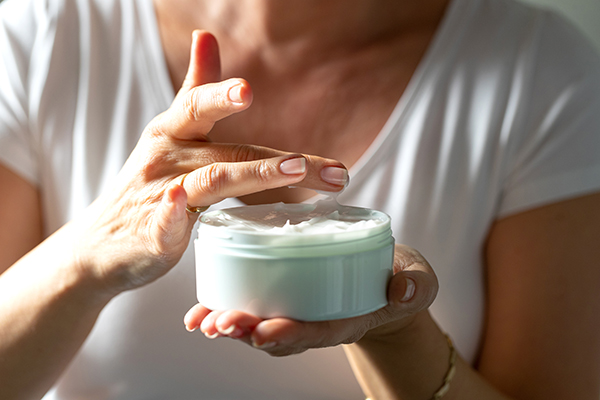How to Get Rid of Cellulite: 6 Expert Tips

The secret to how to get rid of cellulite has stumped (mostly) women since time immemorial. And while it isn’t harmful to your body, it can mess with your self-esteem.
Unfortunately, despite social media ads that claim otherwise, there are no nifty gadgets, creams, or supplements that can “blast away” cellulite for good. Now, the good news: There are a few ways to minimize the appearance of cellulite.
“While it’s tough to completely get rid of cellulite, you can reduce its appearance by losing body fat,” says Trevor Thieme, C.S.C.S. “The leaner you are, the less obvious your cellulite will be.”
Here’s how to get there.
What Is Cellulite?
Cellulite is a dimpling of the skin that results when fat cells accumulate, pushing against it. Its uneven “orange peel” or “cottage cheese” appearance derives from the lattice of connective fibers that attach skin to muscle through a layer of fat.
Think of it like the relationship between the filling and buttons of a tufted cushion.
“There are three structural components to cellulite,” explains dermatologist Bruce Katz, M.D., director of the JUVA Skin & Laser Center and member of the American Academy of Dermatology:
- Fat cells pushing against collagen fibers (connective tissue), causing raised areas in your skin.
- Fibrous bands beneath the skin pulling down and causing depressions (dimples) in your skin.
- Skin laxity (looseness), which allows the first two things to happen.
Up to 90 percent of women have some cellulite, which appears most often around the buttocks and thighs but also occasionally on the belly, breasts, and arms. In men, for whom cellulite is less common, it’s most prevalent in the neck and belly.
Why don’t more men get cellulite?
According to a 2014 study, cellulite is present in about 2 percent of men. The difference is in the arrangement of connective tissue fibers beneath the skin, which differs between genders.
In men, these fibers assume a crisscross pattern that discourages dimpling. In women with cellulite, the fibers tend to run in parallel, vertical rows, forming rectangular compartments that allow fat to bulge out.
What Causes Cellulite?
Hormones, gender, and weight all play a role in cellulite, but often it’s hereditary.
“Research suggests that it has a strong genetic component,” Thieme says. “If your mother had it, there’s a good chance you will, too.”
If this sounds like you, and you’re wondering how to get rid of cellulite, read on for few ways to help your skin appear smoother.
6 Ways to Reduce Cellulite
You can only do so much to overcome your genes, but that shouldn’t discourage you from putting up a fight.
1. Dial in your nutrition

Nutrition is the most important component of weight loss and weight maintenance, Thieme says, so it should play a central role in your efforts to reduce the appearance of cellulite. Dermatologist Adam Mamelak, M.D. agrees.
Focus on gradual and consistent weight loss. That “will help minimize the stress on fibrous compartments, which are what make the skin look like cobblestones,” Mamelak says.
Maintaining a pace of one to two pounds per week can often help the skin and the cords beneath it to adjust to the weight loss.
Lily Adelzadeh, M.D., F.A.A.D., a board-certified dermatologist in Pleasanton, California, recommends a diet that’s low in sodium and includes plenty of fiber. This can help to minimize water retention, which can make cellulite more visible.
No specific food alone will magically reduce your chances of getting cellulite; it’s natural to experience some as you age. However, overall weight loss may help reduce its appearance of cellulite, and a balanced diet that focuses on whole foods like fruits and veggies, lean protein sources, and healthy fats is always a good idea.
Yo-yo dieting doesn’t help either, by the way. In fact, it can result in stretching and contraction of the skin and loss of elastic fibers, all contributors to cellulite, says Beverly Hills-based, board certified plastic surgeon Brent Moelleken, M.D.
Pro tip: Nutrition programs like 2B Mindset and Portion Fix can help you get your nutrition on track. Learn more here.
2. Hydrate amply
Staying hydrated is also key, Adelzadeh says. Skin’s strength and elasticity can be affected by hydration, making water consumption vital to smoothing out the appearance of cellulite.
Sufficient amounts of low-sodium water intake have been correlated with the minimization of cellulite in mild to moderate cases. Seems simple, yet hydration is something many people overlook.
A survey of 300 physicians undertaken by U.K. nonprofit The Natural Hydration Council found that nearly a quarter of patients don’t know how much water they should drink per day. (Answer: at least eight glasses.)
One of the most common reasons reported for doctor visits was fatigue caused by chronic dehydration.
3. Exercise regularly

Combined with proper nutrition, exercise can help you lose fat, and that can assist in minimizing the appearance of cellulite, Thieme says.
Research suggests exercise can also improve body composition and decrease the severity of cellulite by bringing better blood flow to fat tissue.
Pro tip: BODi has hundreds of workouts to choose from. Find the routine that’s right for you.
4. Get a massage
Need a good excuse to book a massage? Some research suggests massage — including vibrational massage — might help improve the appearance of cellulite, Mamelak says.
It’s important, however, to note that research on the connection between massage and cellulite is limited and inconclusive.
That said, there are plenty of other, proven benefits of massage — like easing muscle tension and enhancing exercise recovery — so there’s no downside to giving it a try.
5. Try skincare products with caffeine

No topical product holds the secret to getting rid of cellulite overnight, but over-the-counter creams that contain caffeine can potentially help reduce its appearance, Adelzadeh says, because caffeine prevents excessive accumulation of fat in cells.
“Caffeine works by temporarily constricting the blood vessels, which leads to fat cells shrinking,” she adds. “This can improve the look of an area — but keep in mind they’re not long-term solutions.”
6. Talk to Your Doctor
Historically, there haven’t really been any fast fixes for cellulite. Liposuction, for instance, can actually make it worse by loosening the surrounding skin and causing more depressions in it, says Katz.
That aligns with the guidance of both the American Academy of Dermatology (AAD) and the American Board of Cosmetic Surgery (ABCS). Both organizations, however, do acknowledge several treatments in particular that studies show have been effective in the prolonged minimization of cellulite.
Cellulaze
Known clinically as photomology, Cellulaze is the brand name for this relatively new, in-office, minimally invasive laser treatment. “It addresses all three structural components of cellulite,” says Katz, who performs the procedure in his New York offices.
The process melts the fat pushing up against the skin, cuts the fibrous bands pulling down at the skin, and, finally, stimulates the growth of collagen, the major structural protein of the skin. With one session and minimal downtime, Katz says most people will see a 70 to 80 percent improvement in their cellulite with results lasting a year or longer, according to the AAD and ABCS.
Cellfina
The other treatment option indicated by both organizations in the sustained reduction of cellulite is a procedure called subcision. The FDA-approved version of the method is called Cellfina, in which a needle or blade is inserted a few millimeters below the skin to cut the strands of connective tissue that contribute to cellulite’s bulging appearance.
ABCS claims Cellfina’s effects last the longest of any procedure, with results observed up to three years.
But before going under the knife, it’s helpful to try some lifestyle shifts first — particularly nutrition and exercise.
Create a free BODi account and find out how BODI’s at-home workouts, nutrition programs, and online community work together to help you reach your health and fitness goals.
